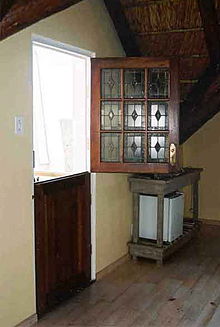Dutch door

A Dutch door (American English), stable door (British English), or half door (Hiberno English), is a door divided horizontally in such a fashion that the bottom half may remain shut while the top half opens. They were known in early New England as a double-hung door.[citation needed] The initial purpose of this door design was to keep animals out of farmhouses or to keep children inside while allowing light and air to filter through the open top; essentially combining a door with a fairly large window. When the top half was open they also allowed a breeze, but stopped the wind from blowing dirt into the house. This type of door was common in the Netherlands in the seventeenth century and appears in Dutch paintings of the period. They were also commonly found in the Dutch cultural areas of New York and New Jersey before the American Revolution.[1]

Dutch doors are often used in North-American passenger train cars to allow crewmen to interact safely with other employees not aboard their trains (or simply to visually inspect their own train) without risking falling from the train. Recent operating rules changes in Canada have rendered the Dutch-doors obsolete, although older rolling stock retains the doors.[citation needed]
The term is also applied to the modified rear doors on selected GMC Safaris and Chevrolet Astros that have a flip up rear window and two small half-size doors underneath.[citation needed]
References
- ^ "Dutch door (American) (34.79a,b)". In Heilbrunn Timeline of Art History. New York: The Metropolitan Museum of Art, 2000 (October 2006)
